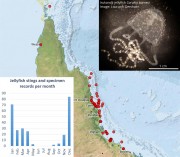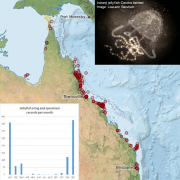NESP TWQ Round 2 - Project 2.2.3 - Early warning systems to minimize the risk of box jellyfish stings by empowering stakeholders
This project aimed to minimise the risk of venomous jellyfish, including Irukandji and box jellyfish, by empowering stakeholders with an early warning system. The project first developed an openly-accessible database combining relevant information from existing sting datasets as well as research data and public records. A forecasting model was then developed using this database for statistical analysis and modelling that relates sting data to environmental conditions in major stinger hotspots on the GBR. The analysis and modelling of previous sting events found wind direction to be the greatest contributing factor, where north-westerly winds contributed to more stings. Tide height was also important, where incoming tides with slow wind speeds led to more stings in Cairns and Townsville beaches, whereas on Whitsunday beaches slow wind speeds and low tides produced more stings.
Project partners included Traditional Owners of the Yirrganydji peope, Surf Life Saving Queensland (SLSQ) and Association of Marine Park Tourism Operators (AMPTO). The project will help empower tourism operators, Traditional Owners and the public to mitigate stinger impacts.
Final reports, journal articles and fact sheets for this project can be found on NESP TWQ hub website.
Images
Datasets

A later version of this dataset exists published 2019-01-18, accessible through the data links on this page.
This dataset contains records of sting events and specimen samples of jellyfish (Irukandji) along the north Queensland coast from December 1998 to March 2017. This dataset contains an extract (265 records in CSV format) of the publicly available data contained in the Venomous Jellyfish Database. The full database contains approximately 3000 sting events from around Australia and includes records from sources that have not yet been cleared for release.

This dataset contains records of sting events and specimen samples of jellyfish (Irukanji, Halo irukanji, Box jellyfish and Morbakka) from the Venomous Jellyfish Database. This dataset contains an extract of 1081 sting events (in CSV format) from along the north Queensland coast between December 1883 to March 2017. The full database contains approximately 3000 sting events from around Australia and includes records from sources that have not yet been cleared for release.

This dataset presents the code written for the analysis and modelling for the Jellyfish Forecasting System for NESP TWQ Project 2.2.3. The Jellyfish Forecasting System (JFS) searches for robust statistical relationships between historical sting events (and observations) and local environmental conditions. These relationships are tested using data to quantify the underlying uncertainties. They then form the basis for forecasting risk levels associated with current environmental conditions.





